Rusty Dot Pearl Udea ferrugalis
Family Crambidae. Subfamily Spilomelinae. Tribe: Udeini
Nelspruit, March 2020 © Richprins
Description
Forewing reddish ochreous, suffused dark reddish brown, cross-lines blackish serrate (zig-zag).
Distribution
All over Africa and Palearctic region.
Links: African Moths
Africa Wild Insect Book: Moths (Lepidoptera)
Moderator: Klipspringer
-
Klipspringer
- Global Moderator
- Posts: 5858
- Joined: Sat Sep 14, 2013 12:34 pm
- Country: Germany
- Contact:
-
Klipspringer
- Global Moderator
- Posts: 5858
- Joined: Sat Sep 14, 2013 12:34 pm
- Country: Germany
- Contact:
Re: AW Insect Book: Moths (Lepidoptera) Nolidae. Chloephorinae
Arch Drab Maurilia arcuata
Family: Nolidae. Subfamily: Chloephorinae. Tribe: Careini
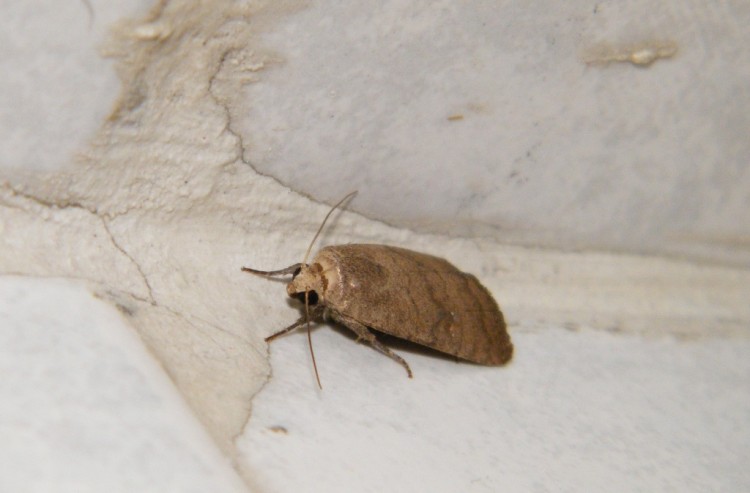 © Richprins
© Richprins
Nelspruit
Description
The forewing is pale ochreous and has dark lines and is rectangular at the apex.
Males have tymbal organs at the base of the abdomen and can produce sound by stridulation.
The Caterpillar of this species has a huge berry-like swelling.
Distribution
Widespread throughout Subsaharan Africa. In the subregion recorded from Namibia, Eswatini, South Africa, Zimbabwe.
Larval Foodplants: Combretum molle, Monotes, Myrica serrata, Myrica aethiopica, Terminalia sericea, Terminalia ivorensis
Links: African Moths
Family: Nolidae. Subfamily: Chloephorinae. Tribe: Careini
Nelspruit
Description
The forewing is pale ochreous and has dark lines and is rectangular at the apex.
Males have tymbal organs at the base of the abdomen and can produce sound by stridulation.
The Caterpillar of this species has a huge berry-like swelling.
Distribution
Widespread throughout Subsaharan Africa. In the subregion recorded from Namibia, Eswatini, South Africa, Zimbabwe.
Larval Foodplants: Combretum molle, Monotes, Myrica serrata, Myrica aethiopica, Terminalia sericea, Terminalia ivorensis
Links: African Moths
-
Klipspringer
- Global Moderator
- Posts: 5858
- Joined: Sat Sep 14, 2013 12:34 pm
- Country: Germany
- Contact:
AW Insect Book: Moths (Lepidoptera) Noctuidae Heliothinae
African Cotton Bollworm, Scarce Bordered Straw Helicoverpa armigera
Family: Noctuidae. Subfamily: Heliothinae
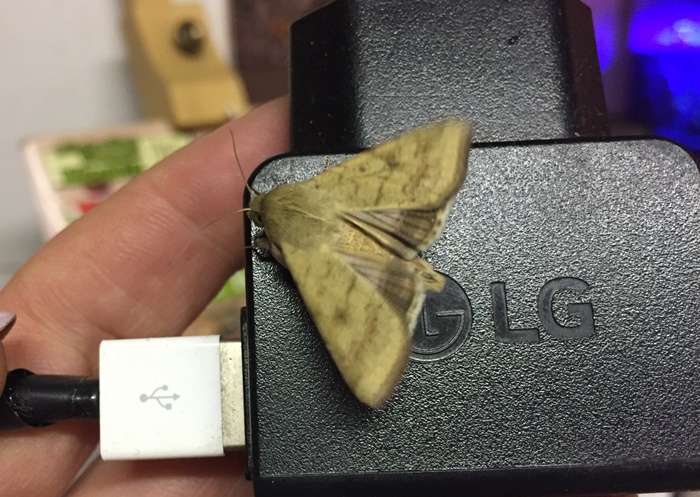 © Flutterby
© Flutterby
Johannesburg
 © nan
© nan
Kgalagadi Transfrontier Park, Nossob
Description
Size: 3.5-4 cm wingspan; 14-18 mm long. Stout-bodied moth which has a broad thorax which tapers toward the abdomen. Colour varies form dull
yellow, pale brown to reddish-brown. A dark band is often present across edge of forewings, with a dark spot in the middle of the wing. Hindwings are paler, greyish-white with dark brown edges.
Distribution
It is found all over Africa.
Biology
The bollworm is a highly polyphagous and destructive pest which attacks over 180 plant species, including most of the cultivated crops in South Africa.
Links: African Moths
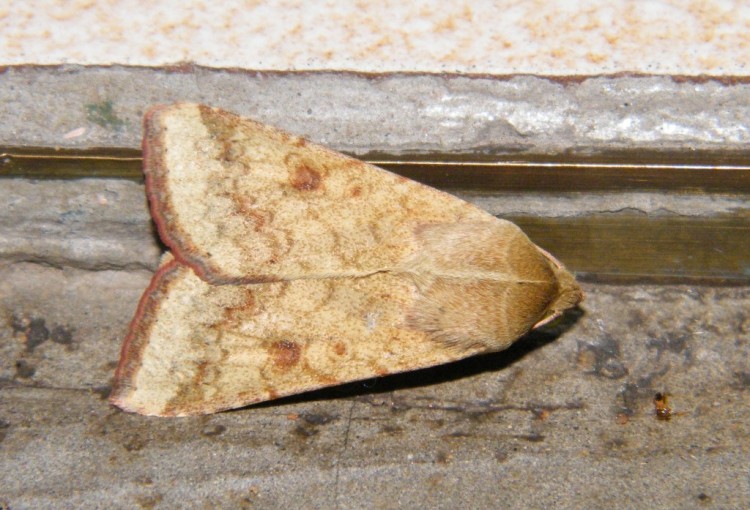 © Richprins
© Richprins
Nelspruit
Family: Noctuidae. Subfamily: Heliothinae
Johannesburg
 © nan
© nanKgalagadi Transfrontier Park, Nossob
Description
Size: 3.5-4 cm wingspan; 14-18 mm long. Stout-bodied moth which has a broad thorax which tapers toward the abdomen. Colour varies form dull
yellow, pale brown to reddish-brown. A dark band is often present across edge of forewings, with a dark spot in the middle of the wing. Hindwings are paler, greyish-white with dark brown edges.
Distribution
It is found all over Africa.
Biology
The bollworm is a highly polyphagous and destructive pest which attacks over 180 plant species, including most of the cultivated crops in South Africa.
Links: African Moths
Nelspruit
-
Klipspringer
- Global Moderator
- Posts: 5858
- Joined: Sat Sep 14, 2013 12:34 pm
- Country: Germany
- Contact:
Re: Africa Wild Insect Book: Moths (Lepidoptera)
Edible Monkey Striphnopteryx edulis
Superfamily Bombycoidea. Family Eupterotidae. Subfamily Eupterotinae
 © RogerFraser
© RogerFraser
 © RogerFraser
© RogerFraser
 © RogerFraser
© RogerFraser
Durban
Striphnopteryx edulis (Boisduval, 1847) is a large southern African species of Eupterotidae (Monkey Moths) and the type and only species of Striphnopteryx Wallengren, 1858.
There are about 70 species of Monkey Moth in southern Africa, varying in size from about 40 mm to over 100 mm
Description
Wingspan: 110 mm. Large, grey, softly hairy moth.
Distribution
Striphnopteryx edulis occurs from the south-eastern parts of South Africa and Eswatini north into Mozambique and eastern Zimbabwe and is rather common in KwaZulu-Natal.
Habitat
This species is commonly found in gardens along the east coastal belt, forests and savanna.
Biology
These night-flying moths are attracted to light and commonly enter homes.
Larval foodplants: Cordia caffra, Tecoma capensis.
Links:
African Moths
https://www.zoologicalbulletin.de/BzB_V ... %20al..pdf
Superfamily Bombycoidea. Family Eupterotidae. Subfamily Eupterotinae
Durban
Striphnopteryx edulis (Boisduval, 1847) is a large southern African species of Eupterotidae (Monkey Moths) and the type and only species of Striphnopteryx Wallengren, 1858.
There are about 70 species of Monkey Moth in southern Africa, varying in size from about 40 mm to over 100 mm
Description
Wingspan: 110 mm. Large, grey, softly hairy moth.
Distribution
Striphnopteryx edulis occurs from the south-eastern parts of South Africa and Eswatini north into Mozambique and eastern Zimbabwe and is rather common in KwaZulu-Natal.
Habitat
This species is commonly found in gardens along the east coastal belt, forests and savanna.
Biology
These night-flying moths are attracted to light and commonly enter homes.
Larval foodplants: Cordia caffra, Tecoma capensis.
Links:
African Moths
https://www.zoologicalbulletin.de/BzB_V ... %20al..pdf
-
Klipspringer
- Global Moderator
- Posts: 5858
- Joined: Sat Sep 14, 2013 12:34 pm
- Country: Germany
- Contact:
Re: AW Insect Book Moths (Lepidoptera) Psychidae Oiketicinae
Bagworm Moth Eumeta sp., possibly Eumeta hardenbergi
Superfamily: Tineoidea. Family: Psychidae. Subfamily: Oiketicinae
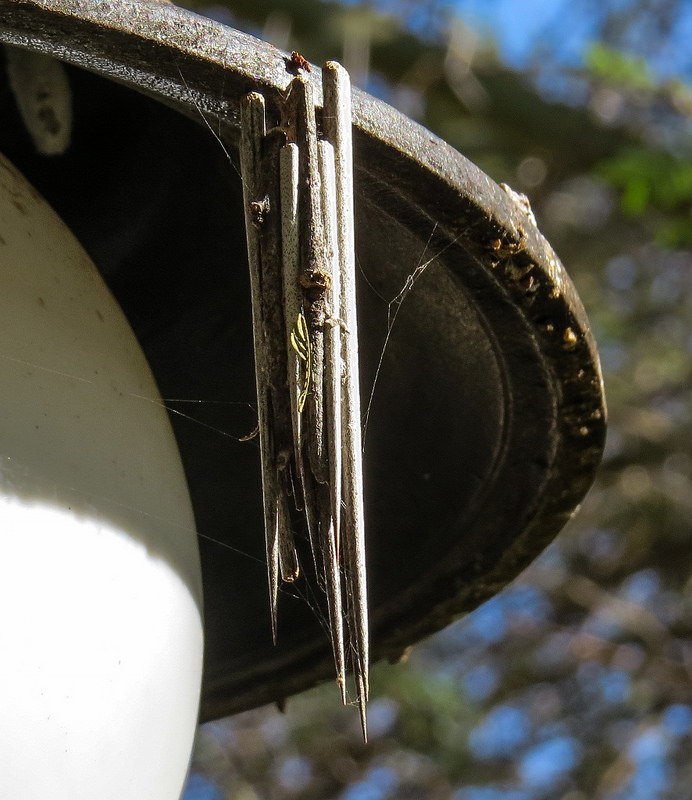 © steamtrainfan
© steamtrainfan

Bag architecture: composed by Fever Tree Thorns © steamtrainfan
The family Psychidae is world-wide distributed. The bagworm family includes approximately 1000 species, all of which complete larval development within a self-enclosing bag. The family is remarkable in that female aptery occurs in over half of the known species and within 9 of the 10 currently recognized subfamilies. Females are winged in the most primitive genera only, losing wings, legs and other appendages during their evolutionary history.
Young larvae build their bag immediately after the hatchling. They live within the bag until the mature stage. Psychidae larvae are commonly polyphagous.
Description
Length of larva: 22-25 mm; Length of bag: ♂ 25-35 mm, ♀ 30-55 mm; Length of female: 20 mm; Wingspan: 29-35 mm.
The adult male is a typical winged moth, with bipectinate antennae, relatively long legs, and reduced mouthparts.
Distribution
Mocambique, South Africa, Tanzania.
Biology
The Eumeta larva spins together thorns and twigs of Senegalia and Vachellia trees. The sharp ends of the thorns always point to the apex, away from where the larva peeps out. The head and thoracic legs protrude from the anterior opening of the bag, allowing the larva to feed and move over the plant.
The wingless, fertilized females do not emerge, but lay their eggs in the bags. The newly-hatched larvae immediately spin long gossamer threads to aid dispersal. The larvae of E. hardenbergi are wind-dispersed.
Foodplants: Many fruit-trees, Quercus spp., Ligustrum spp., Rosa spp., Macrocarpa spp., Acacia spp., Citrus spp. Schinus molle L., Eucalyptus spp.,
Links:
https://www.researchgate.net/publicatio ... a/download
https://www.researchgate.net/publicatio ... f/download
Superfamily: Tineoidea. Family: Psychidae. Subfamily: Oiketicinae
 © steamtrainfan
© steamtrainfan
Bag architecture: composed by Fever Tree Thorns © steamtrainfan
The family Psychidae is world-wide distributed. The bagworm family includes approximately 1000 species, all of which complete larval development within a self-enclosing bag. The family is remarkable in that female aptery occurs in over half of the known species and within 9 of the 10 currently recognized subfamilies. Females are winged in the most primitive genera only, losing wings, legs and other appendages during their evolutionary history.
Young larvae build their bag immediately after the hatchling. They live within the bag until the mature stage. Psychidae larvae are commonly polyphagous.
Description
Length of larva: 22-25 mm; Length of bag: ♂ 25-35 mm, ♀ 30-55 mm; Length of female: 20 mm; Wingspan: 29-35 mm.
The adult male is a typical winged moth, with bipectinate antennae, relatively long legs, and reduced mouthparts.
Distribution
Mocambique, South Africa, Tanzania.
Biology
The Eumeta larva spins together thorns and twigs of Senegalia and Vachellia trees. The sharp ends of the thorns always point to the apex, away from where the larva peeps out. The head and thoracic legs protrude from the anterior opening of the bag, allowing the larva to feed and move over the plant.
The wingless, fertilized females do not emerge, but lay their eggs in the bags. The newly-hatched larvae immediately spin long gossamer threads to aid dispersal. The larvae of E. hardenbergi are wind-dispersed.
Foodplants: Many fruit-trees, Quercus spp., Ligustrum spp., Rosa spp., Macrocarpa spp., Acacia spp., Citrus spp. Schinus molle L., Eucalyptus spp.,
Links:
https://www.researchgate.net/publicatio ... a/download
https://www.researchgate.net/publicatio ... f/download
-
Klipspringer
- Global Moderator
- Posts: 5858
- Joined: Sat Sep 14, 2013 12:34 pm
- Country: Germany
- Contact:
Re: AW Insect Book: Moths (Lepidoptera) Noctuidae Catocalinae
Double-banded Lines Grammodes bifasciata
Family: Noctuidae. Subfamily: Catocalinae
or: Family: Erebidae. Subfamily: Erebinae
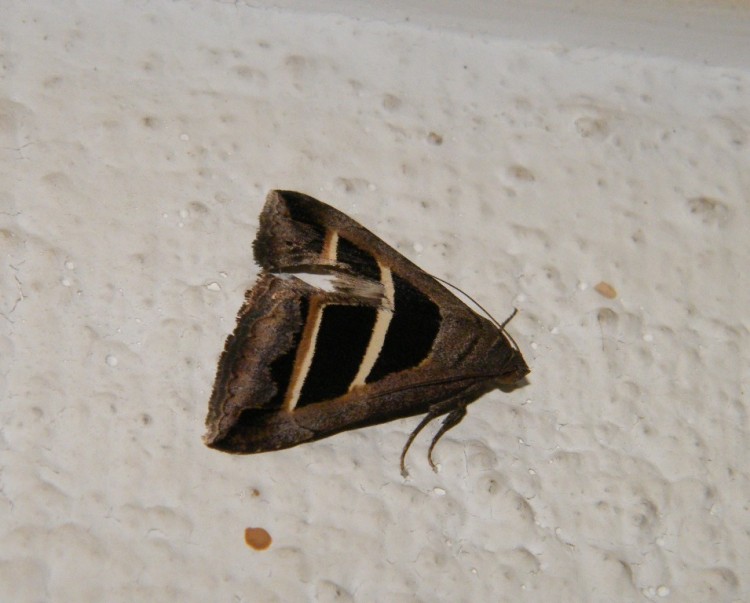 © Richprins
© Richprins
Nelspruit
Description
Wingspan 30-35 mm. The front wings when at rest, are dark brown crossed by two white-colored parallel lines in the discal and post discal regions. The submarginal area, and radial and coastal areas, they are walnut color, framing the dark brown area. The rear wing is faded brown with a much clearer line in the discal area.
Taxonomic Notes
The Noctuidae family of moths are often classified in the family Erebidae now. This re-classification has not yet met with general consensus, and many resources and publications still follow the older classification scheme and place it it the family Noctuidae.
Distribution
It is found in Africa and southern Europe.
Links: African Moths
Family: Noctuidae. Subfamily: Catocalinae
or: Family: Erebidae. Subfamily: Erebinae
Nelspruit
Description
Wingspan 30-35 mm. The front wings when at rest, are dark brown crossed by two white-colored parallel lines in the discal and post discal regions. The submarginal area, and radial and coastal areas, they are walnut color, framing the dark brown area. The rear wing is faded brown with a much clearer line in the discal area.
Taxonomic Notes
The Noctuidae family of moths are often classified in the family Erebidae now. This re-classification has not yet met with general consensus, and many resources and publications still follow the older classification scheme and place it it the family Noctuidae.
Distribution
It is found in Africa and southern Europe.
Links: African Moths
-
Klipspringer
- Global Moderator
- Posts: 5858
- Joined: Sat Sep 14, 2013 12:34 pm
- Country: Germany
- Contact:
Re: AW Insect Book Moths (Lepidoptera) Tineoidea, Tineidae, Tineinae
Household Case-bearing Moth Phereoeca sp.
Superfamily: Tineoidea. Family: Tineidae. Subfamily: Tineinae
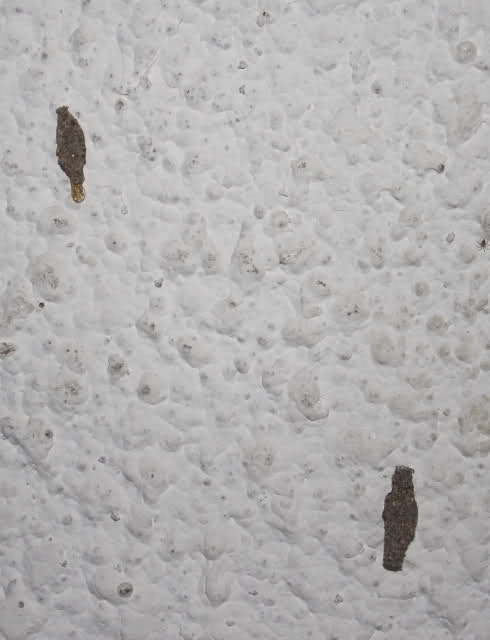 © Flutterby
© Flutterby
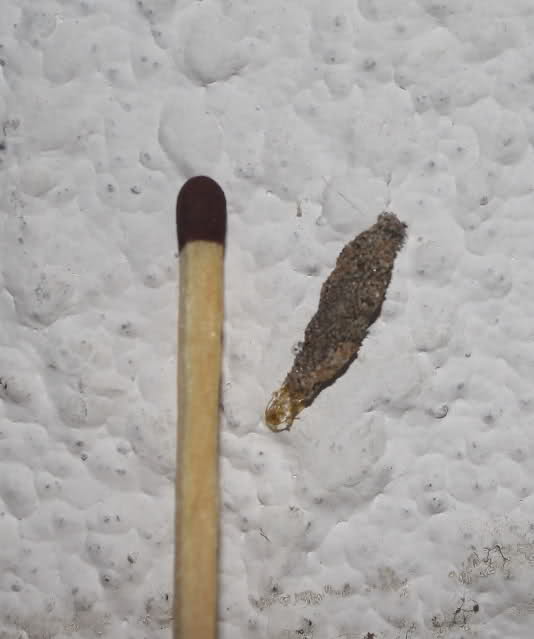 © Flutterby
© Flutterby
Garage wall, Johannesburg
Tineid Moths (Tineidae)
This family includes the well-known clothes moth and some related species that can cause quite some damage in human habitations. The larvae of most species are fungivorous, living on and often boring into fungi and lichens. Other food sources (which may or may not include fungal matter) are fallen leaves and other decomposing plant substances (detritus), bat guano in caves, dead insects in or near spiders’ webs, mammal cadavers, faeces and feathers in birds’ nests. From these it was only a small transition step to man-made products manufactured from wool, fur, and feathers (textiles, carpets, rugs, pillows). Some species infest stored food products. The larvae of many – but not all – species build portable cases from which they feed; some live in tubes lined with silk in or under their food (e.g. the clothes moth). In many species, the adults typically have a bush of erect scales on their head, often bright yellow or white. The family comprises about 3,000 species worldwide.
The caterpillars of Phereoeca species make a protective silk case, camouflaged with sand grains. Caterpillars remain in portable cases and are usually found crawling on walls.
Phereoeca species may be household pests, feeding on dead insects and fallen human hair.
http://downloads.hindawi.com/journals/p ... 084541.pdf
Superfamily: Tineoidea. Family: Tineidae. Subfamily: Tineinae
 © Flutterby
© Flutterby © Flutterby
© FlutterbyGarage wall, Johannesburg
Tineid Moths (Tineidae)
This family includes the well-known clothes moth and some related species that can cause quite some damage in human habitations. The larvae of most species are fungivorous, living on and often boring into fungi and lichens. Other food sources (which may or may not include fungal matter) are fallen leaves and other decomposing plant substances (detritus), bat guano in caves, dead insects in or near spiders’ webs, mammal cadavers, faeces and feathers in birds’ nests. From these it was only a small transition step to man-made products manufactured from wool, fur, and feathers (textiles, carpets, rugs, pillows). Some species infest stored food products. The larvae of many – but not all – species build portable cases from which they feed; some live in tubes lined with silk in or under their food (e.g. the clothes moth). In many species, the adults typically have a bush of erect scales on their head, often bright yellow or white. The family comprises about 3,000 species worldwide.
The caterpillars of Phereoeca species make a protective silk case, camouflaged with sand grains. Caterpillars remain in portable cases and are usually found crawling on walls.
Phereoeca species may be household pests, feeding on dead insects and fallen human hair.
http://downloads.hindawi.com/journals/p ... 084541.pdf
-
Klipspringer
- Global Moderator
- Posts: 5858
- Joined: Sat Sep 14, 2013 12:34 pm
- Country: Germany
- Contact:
Re: AW Insect Book: Moths (Lepidoptera) Noctuidae Catocalinae
Lienard's Achaea Achaea lienardi
Family: Noctuidae. Subfamily: Catocalinae
or: Family: Erebidae. Subfamiy: Calpinae
Kruger National Park, Oilfants camp, April 2016 © arks
Description
Achaea lienardi is very variable. There is a paper written almost a century ago which says that if you make a collection of 50 of these moths, scarcely two are alike. The little white markings on the trailing margin of the hindwing are a constant feature (but can be covered by the way the moth is resting) and the shape of the postmedial line on the forewing is diagnostic.
The wings are a greyish-brown colour. The forewings have an oblique but almost straight inner line and the hindwing a brown colour with a trace of white in the centre and white marginal spots. The length of the forewing is 25-30 mm.
Distribution
It is found in most countries in tropical Africa from Egypt to South Africa. In South Africa, Achaea lienardi occurs mainly along the coastal region of the Eastern Cape, and northward into the Lowveld of Eswatini, Mpumalanga and Limpopo. There are also records in the Northern Cape and the Western Cape from major citrus production regions along the Orange River and along the Olifants River.
Biology
The larva is a semi-looper and has been recorded feeding on various plants, belonging to the genera Maerua, Pappea, Rhus, Citrus, Schotia, Sideroxylon, Ptaeroxylon, Acacia, Allophylus, Croton, Pinus and Ricinus.
Most of the species in the genus Achaea are attracted to light and to overripe fruit. This is one of the fruit-feeding moths. There are two broad categories of fruit-feeding moths, fruit-piercing moths and fruit-sucking moths. This is a fruit-sucking moth; in other words it sucks the juice out of fruit which have already been compromised. Their proboscis is simply not sharp and rigid enough to pierce the skin of fruit. Instead they, together with many other insects, exploit bleeding and over-ripe fruit for the sugar.
Links:
African Moths
Family: Noctuidae. Subfamily: Catocalinae
or: Family: Erebidae. Subfamiy: Calpinae
Kruger National Park, Oilfants camp, April 2016 © arks
Description
Achaea lienardi is very variable. There is a paper written almost a century ago which says that if you make a collection of 50 of these moths, scarcely two are alike. The little white markings on the trailing margin of the hindwing are a constant feature (but can be covered by the way the moth is resting) and the shape of the postmedial line on the forewing is diagnostic.
The wings are a greyish-brown colour. The forewings have an oblique but almost straight inner line and the hindwing a brown colour with a trace of white in the centre and white marginal spots. The length of the forewing is 25-30 mm.
Distribution
It is found in most countries in tropical Africa from Egypt to South Africa. In South Africa, Achaea lienardi occurs mainly along the coastal region of the Eastern Cape, and northward into the Lowveld of Eswatini, Mpumalanga and Limpopo. There are also records in the Northern Cape and the Western Cape from major citrus production regions along the Orange River and along the Olifants River.
Biology
The larva is a semi-looper and has been recorded feeding on various plants, belonging to the genera Maerua, Pappea, Rhus, Citrus, Schotia, Sideroxylon, Ptaeroxylon, Acacia, Allophylus, Croton, Pinus and Ricinus.
Most of the species in the genus Achaea are attracted to light and to overripe fruit. This is one of the fruit-feeding moths. There are two broad categories of fruit-feeding moths, fruit-piercing moths and fruit-sucking moths. This is a fruit-sucking moth; in other words it sucks the juice out of fruit which have already been compromised. Their proboscis is simply not sharp and rigid enough to pierce the skin of fruit. Instead they, together with many other insects, exploit bleeding and over-ripe fruit for the sugar.
Links:
African Moths
-
Klipspringer
- Global Moderator
- Posts: 5858
- Joined: Sat Sep 14, 2013 12:34 pm
- Country: Germany
- Contact:
Re: AW Insect Book Moths Lepidoptera, Sphingidae, Macroglossinae
V Nephele Nephele vau
Family Sphingidae. Subfamily Macroglossinae. Tribe Macroglossini
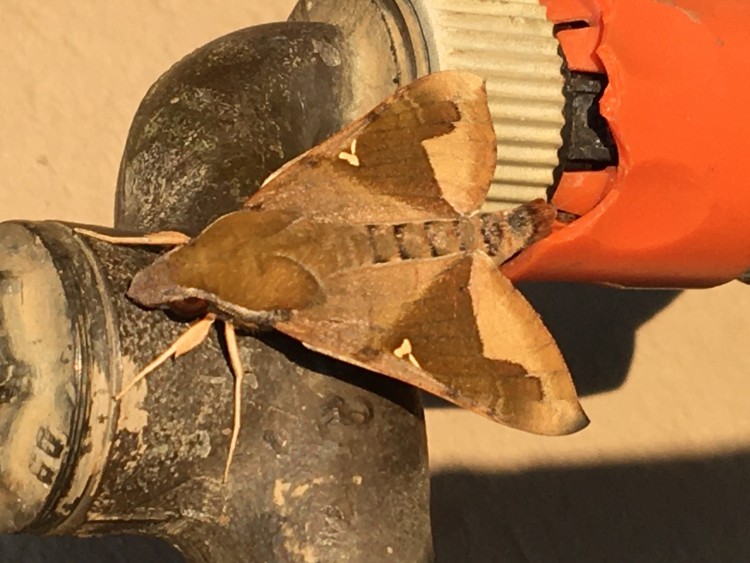 © Alf
© Alf
Male, Centurion
Description
The length of the forewings is 25–31 mm. Abdomen black-banded. Anal tuft 3-cornered in male, truncate in female. The forewings have a large dark olive to reddish-brown subtriangular spot and a V-shaped golden-white stigma. The hindwings are olive bordered with brown or copper. This species differs a good deal in colour.
Distribution
Common throughout most of Africa south of the Sahara: Central African Republic, Congo, DRCongo, Eritrea, Ethiopia, Ghana, Kenya, Nigeria, Rwanda, South Africa, Sudan, Tanzania, Uganda, Zambia, Zimbabwe.
Biology
Larval foodplants: Carissa edulis
Links: African Moths
Family Sphingidae. Subfamily Macroglossinae. Tribe Macroglossini
Male, Centurion
Description
The length of the forewings is 25–31 mm. Abdomen black-banded. Anal tuft 3-cornered in male, truncate in female. The forewings have a large dark olive to reddish-brown subtriangular spot and a V-shaped golden-white stigma. The hindwings are olive bordered with brown or copper. This species differs a good deal in colour.
Distribution
Common throughout most of Africa south of the Sahara: Central African Republic, Congo, DRCongo, Eritrea, Ethiopia, Ghana, Kenya, Nigeria, Rwanda, South Africa, Sudan, Tanzania, Uganda, Zambia, Zimbabwe.
Biology
Larval foodplants: Carissa edulis
Links: African Moths
-
Klipspringer
- Global Moderator
- Posts: 5858
- Joined: Sat Sep 14, 2013 12:34 pm
- Country: Germany
- Contact:
Re: AW Insect Book: Moths (Lepidoptera) Gelechioidea, Scythrididae
Flower Moth
Superfamily Gelechioidea. Family Scythrididae.
Garden in Darling, Western Cape © arks
Scythrididae (flower moths) is a family of small moths in the superfamily Gelechioidea. The family embraces about 680 species assigned to about 30 genera. They are distributed worldwide. The scythridids typically are associated primarily with arid areas (steppe, savannah, semi-desert, etc.).
Scythrididae adults are smallish to mid-sized moths, which when at rest appear teardrop-shaped. The species of Scythrididae are rather small moths having a wingspan of 6–30 mm with the most common value in the span 10–15 mm. In temperate and boreal regions the moths are mostly dark with brownish or greyish coloration, while in the tropic regions the scythridids frequently have pale forewings with beige or ivory ground colour. This is most certainly a result of adaptation to the parched environment and the climate in general; dark insects benefit from the fainter solar radiation in the northerly or southerly latitudes.
A typical scythridid has lanceolate wings with highly fringed edges, the hindwing fringes longer than the largest width of the wing. In resting pose the moth seems elongated drop-shaped with round head. A scythridid may easily be confused with micro-moth species in other families.
The genus Eretmocera embraces small, brilliant or extremely glaringly coloured moths, usually with strong forewing coloration in blackish, red and/or yellow. The hindwings and abdomen are in general also brightly coloured in red or yellow. Only a few species are more modestly coloured in fuscous tinges but may in most cases still be identified as members of Eretmocera due to the coloration of the abdomen. A pair of cream spots are usually present on metanotum. Many species have antennae conspicuously thickened by black, erect scales in basal half or in middle third.
Links:
http://esperiana.net/mediapool/86/86251 ... 7_7-46.pdf
Superfamily Gelechioidea. Family Scythrididae.
Garden in Darling, Western Cape © arks
Scythrididae (flower moths) is a family of small moths in the superfamily Gelechioidea. The family embraces about 680 species assigned to about 30 genera. They are distributed worldwide. The scythridids typically are associated primarily with arid areas (steppe, savannah, semi-desert, etc.).
Scythrididae adults are smallish to mid-sized moths, which when at rest appear teardrop-shaped. The species of Scythrididae are rather small moths having a wingspan of 6–30 mm with the most common value in the span 10–15 mm. In temperate and boreal regions the moths are mostly dark with brownish or greyish coloration, while in the tropic regions the scythridids frequently have pale forewings with beige or ivory ground colour. This is most certainly a result of adaptation to the parched environment and the climate in general; dark insects benefit from the fainter solar radiation in the northerly or southerly latitudes.
A typical scythridid has lanceolate wings with highly fringed edges, the hindwing fringes longer than the largest width of the wing. In resting pose the moth seems elongated drop-shaped with round head. A scythridid may easily be confused with micro-moth species in other families.
The genus Eretmocera embraces small, brilliant or extremely glaringly coloured moths, usually with strong forewing coloration in blackish, red and/or yellow. The hindwings and abdomen are in general also brightly coloured in red or yellow. Only a few species are more modestly coloured in fuscous tinges but may in most cases still be identified as members of Eretmocera due to the coloration of the abdomen. A pair of cream spots are usually present on metanotum. Many species have antennae conspicuously thickened by black, erect scales in basal half or in middle third.
Links:
http://esperiana.net/mediapool/86/86251 ... 7_7-46.pdf


